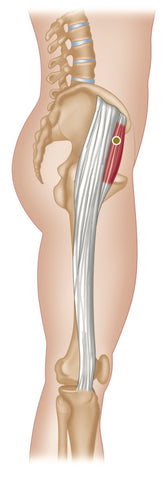Unlocking Hip Mobility | Soft Tissue Therapy for TFL Restrictions
The tensor fasciae latae (TFL) muscle plays a crucial role as it provides stability through the knee and pelvis
TFL trigger points are associated with a wide range of common hip and knee dysfunction are often encountered in a highly resistant form.
Pain from these trigger points is often experienced at the level of the greater trochanter of the hip joint. The pain is almost always more intense when walking or running.

Referred Pain
Pain is also commonly referred down the lateral thigh and to the knee. In many cases the pain will be referred to the knee only.
In the video above, Stuart hinds demonstrates part of the NAT hip protocol used to address TFL trigger points.
About the TFL
Latin: Tendere = "to stretch"; Fasciae = "of the band"; Latae = "broad"
The tensor fasciae latae muscle lies anterior to the gluteus maximus, on the lateral side of the hip.
Origin
Anterior part of outer lip of iliac crest, and outer surface of ASIS.
Insertion
Joins the IT tract just below level of greater trochanter.
Action
Flexes, abducts, and medially rotates the hip joint.
Tenses fascia lata, thus stabilizing the knee joint.
Redirects rotational forces produced by gluteus maximus.
Nerve
Superior gluteal nerve, L4, 5, S1.
Basic Functional Movement
Example: Walking.
Soft Tissue Therapy for TFL Restrictions
The tensor fasciae latae (TFL) is a small but mighty muscle located on the side of the hip, playing a crucial role in hip stability and mobility. However, due to factors such as prolonged sitting, repetitive movements, and muscular imbalances, the TFL can become tight and restricted, leading to discomfort, pain, and limited range of motion in the hip joint.
Fortunately, soft tissue therapy offers a highly effective solution for addressing TFL restrictions and restoring optimal function to the hip. By targeting the TFL and surrounding muscles with specific manual techniques, soft tissue therapy can help release tension, alleviate tightness, and improve flexibility, allowing for greater mobility and comfort in the hip region.
Here are some key benefits of incorporating soft tissue therapy into your treatment plan for TFL restrictions:
Release of Tension: Soft tissue therapy techniques, such as myofascial release and trigger point therapy, target the tight, restricted fibers of the TFL, helping to release tension and restore suppleness to the muscle.
Improved Range of Motion: By addressing restrictions in the TFL and surrounding soft tissues, soft tissue therapy can help improve hip mobility and flexibility, allowing for smoother, more fluid movement in activities such as walking, running, and squatting.
Pain Relief: TFL restrictions can contribute to hip and lower back pain, as well as discomfort in the IT band and knee. Soft tissue therapy can help alleviate pain by reducing tension and inflammation in the TFL and associated structures.
Correction of Muscular Imbalances: Soft tissue therapy can help identify and address muscular imbalances that may be contributing to TFL restrictions, promoting better alignment and function throughout the hip complex.
Prevention of Injury: By maintaining optimal soft tissue health and mobility in the TFL and surrounding muscles, soft tissue therapy can help reduce the risk of overuse injuries and strain, allowing individuals to engage in physical activities safely and effectively.
Incorporating soft tissue therapy techniques into your treatment regimen for TFL restrictions can yield significant benefits, helping to restore balance, mobility, and comfort to the hip region. Whether you're dealing with discomfort during daily activities or looking to optimize athletic performance, soft tissue therapy offers a holistic and effective approach to addressing TFL restrictions and promoting overall musculoskeletal health.
If you're experiencing TFL restrictions or hip discomfort, consider consulting with a qualified soft tissue therapist or healthcare provider to develop a personalized treatment plan tailored to your specific needs and goals. With targeted soft tissue therapy, you can unlock the full potential of your hips and enjoy greater freedom of movement and comfort in your daily life.
About Niel Asher Education
Niel Asher Education (NAT Global Campus) is a globally recognised provider of high-quality professional learning for hands-on health and movement practitioners. Through an extensive catalogue of expert-led online courses, NAT delivers continuing education for massage therapists, supporting both newly qualified and highly experienced professionals with practical, clinically relevant training designed for real-world practice.
Beyond massage therapy, Niel Asher Education offers comprehensive continuing education for physical therapists, continuing education for athletic trainers, continuing education for chiropractors, and continuing education for rehabilitation professionals working across a wide range of clinical, sports, and wellness environments. Courses span manual therapy, movement, rehabilitation, pain management, integrative therapies, and practitioner self-care, with content presented by respected educators and clinicians from around the world.
Known for its high production values and practitioner-focused approach, Niel Asher Education emphasises clarity, practical application, and professional integrity. Its online learning model allows practitioners to study at their own pace while earning recognised certificates and maintaining ongoing professional development requirements, making continuing education accessible regardless of location or schedule.
Through partnerships with leading educational platforms and organisations worldwide, Niel Asher Education continues to expand access to trusted, high-quality continuing education for massage therapists, continuing education for physical therapists, continuing education for athletic trainers, continuing education for chiropractors, and continuing education for rehabilitation professionals, supporting lifelong learning and professional excellence across the global therapy community.

Continuing Professional Education
Looking for Massage Therapy CEUs, PT and ATC continuing education, chiropractic CE, or advanced manual therapy training? Explore our evidence-based online courses designed for hands-on professionals.


















